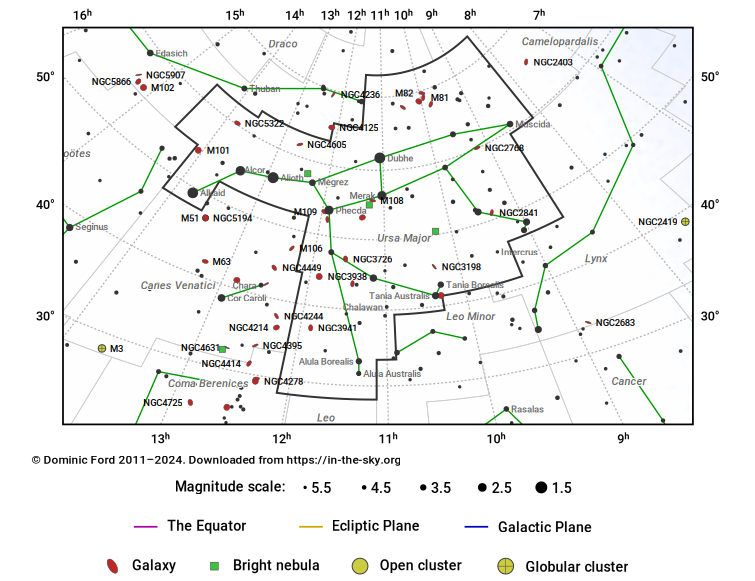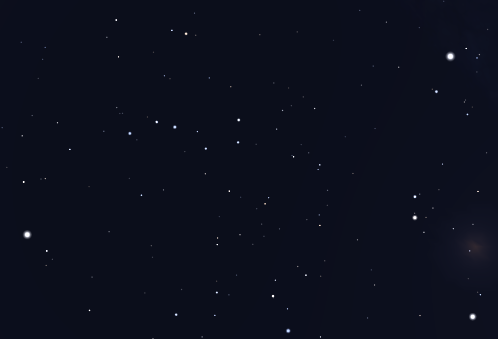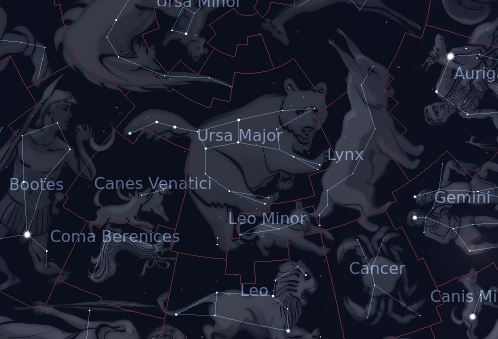The Constellation Ursa Major
Better known by its nicknames ‘the Big Dipper’ or ‘the Plough’, Ursa Major is among the most instantly recognisable groupings of stars. It is also the third largest of all the constellations.
The Ancient Greeks identified Ursa Major as a bear – its name is Latin for ‘the greater bear’. Some historians believe this tradition dates back at least 10,000 years.
Together with Orion and the Pleiades (M45), it is one of only three astronomical entities which appear in the Bible.
All but one of the seven stars which make up the main body of the Big Dipper are second-magnitude stars. The star Mizar, which forms the bend in the ladle's handle, is in fact a double-star with a close neighbor Alcor, which can easily be seen with the unaided eye. The ability to distinguish them is often quoted as having been an ancient sight test, though most people are able to do so.
The stars Merak and Dubhe are often called the ‘pointer stars’ because they form a line which points directly to Polaris, the pole star.
Ursa Major also contains countless deep sky objects, including the bright face-on spiral galaxy M81 and its close companion M82. Close to the handle of the ladle lies the Pinwheel Galaxy (M101).
Mythology
In Greek mythology, Ursa Major is identified as Callisto, one of Zeus' many lovers. It is one of three constellations which commemorate what is surely the most unsuccessful meet-the-parents dinner party in history.
Zeus was having an affair with Callisto, and they'd just had a child called Arcas. Zeus thought he'd turn up at her father's house for dinner, but it all started going wrong when his lover's father thought it would be a clever idea to test whether it was really Zeus, by chopping up Arcas and putting him in the stew (eh?).
Unfortunately, the dinner guest really was Zeus, and he got rather annoyed. Thunderbolts flew in all directions, killing all of Callisto's brothers. Callisto got turned into a bear, her father turned into a wolf. But luckily Zeus was able to reassemble all the bits of Arcas and bring him back to life, with a bit of help from Maia.
But Zeus forgot to tell Arcas that his mother was now a bear, so he started hunting her with a spear. Realising it had all gone horribly wrong, Zeus decided there was nothing for it but to put Arcas in the sky as the constellation Bootes, Callisto in the sky as Ursa Major, and her father in the sky as the wolf, Lupus. Maia, meanwhile, is the central star of the Pleiades (M45).
Ancient
3.1% of the sky
1279.7 square degrees
Ursa Major contains the following Messier objects: M40, M81, M82, M97, M101, M108, M109.
Ursa Major contains no Caldwell objects
The following constellations neighbor Ursa Major: Bootes, Camelopardalis, Canes Venatici, Coma Berenices, Draco, Leo, Leo Minor, Lynx.
Hover the pointer over the name of an object to highlight its position on the starchart to the right, or click to see more information.
| Stars | Open Clusters | Globular Clusters | Galaxies |
| Alioth (mag 1.8) | NGC 3231 | Messier 81 (mag 6.9) | |
| Dubhe (mag 1.8) | NGC 2726 (mag 7.8) | ||
| Alkaid (mag 1.9) | Messier 101 (mag 7.9) | ||
| Mizar (mag 2.2) | Messier 82 (mag 8.4) | ||
| Merak (mag 2.4) | NGC 3184 (mag 9.8) | ||
| Phecda (mag 2.4) | NGC 2768 (mag 9.9) | ||
| ψ-UMa (mag 3.0) | Messier 109 (mag 9.9) | ||
| Tania Australis (mag 3.0) | NGC 3077 (mag 9.9) | ||
| Talitha (mag 3.1) | Messier 108 (mag 10.1) | ||
| θ-UMa (mag 3.2) | NGC 3675 (mag 10.1) | ||
| Megrez (mag 3.3) | NGC 3953 (mag 10.1) | ||
| Muscida (mag 3.4) | NGC 5322 (mag 10.1) | ||
| Tania Borealis (mag 3.4) | NGC 2976 (mag 10.2) | ||
| Alula Borealis (mag 3.5) | NGC 2841 (mag 10.2) | ||
| κ-UMa (mag 3.6) | NGC 4605 (mag 10.3) | ||
| h-UMa (mag 3.6) | NGC 3938 (mag 10.4) | ||
| χ-UMa (mag 3.7) | NGC 3941 (mag 10.4) | ||
| υ-UMa (mag 3.8) | NGC 3198 (mag 10.4) | ||
| ζ-UMa (mag 3.9) | NGC 3631 (mag 10.4) | ||
| Alcor (mag 4.0) | IC 2574 (mag 10.5) | ||
| TYC2520-2634-1 (mag 4.3) | NGC 3726 (mag 10.5) | ||
| Alula Australis (mag 4.4) | NGC 4088 (mag 10.5) | ||
| f-UMa (mag 4.5) | NGC 2985 (mag 10.5) | ||
| 26-UMa (mag 4.5) | NGC 3359 (mag 10.6) | ||
| DK UMa (mag 4.6) | NGC 4096 (mag 10.6) | ||
| φ-UMa (mag 4.6) | NGC 3893 (mag 10.6) | ||
| π²-UMa (mag 4.6) | NGC 3718 (mag 10.7) | ||
| τ-UMa (mag 4.6) | NGC 3079 (mag 10.7) | ||
| 83-UMa (mag 4.7) | NGC 3898 (mag 10.7) | ||
| ω-UMa (mag 4.7) | NGC 3945 (mag 10.8) |




